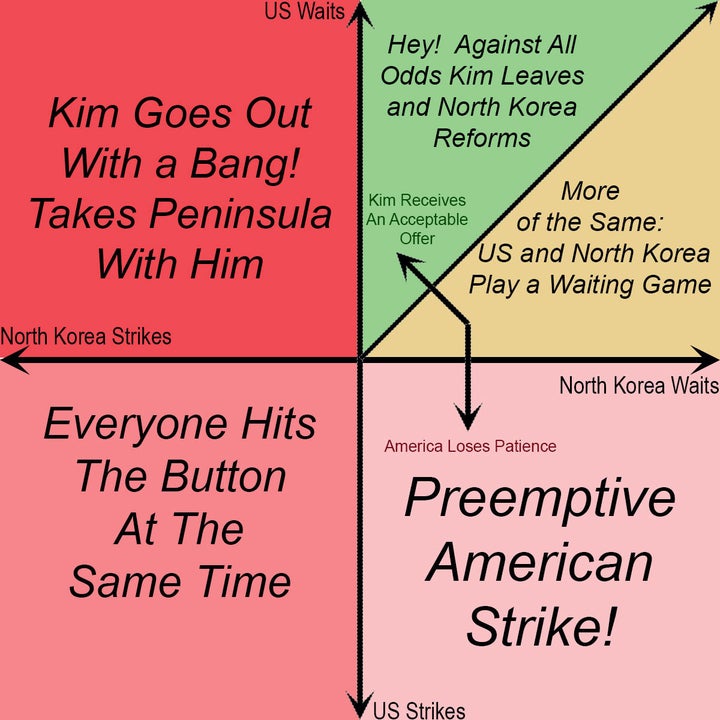The standoff between the US and North Korea appears as pressing and as intractable as any problem the world now faces in international diplomacy.
The North Korean regime has long understood that it is a failed state, has long understood that it is a pariah, and has long understood that its leaders have violated virtually all norms of international behavior. The Kim family fears that its country will be overrun, and it fears that its members will be tried for an array of offenses, including war crimes. Their principal interest is their personal survival. To ensure their survival the Kim family has engaged in a range of activities that paradoxically are combining to ensure its destruction if it remains on its current course. In particular, it seeks to develop a nuclear strike force and the mechanisms to deliver nuclear warheads to targets including US allies, US bases in the Far East, and the Western portions of the US Mainland. Additionally, it seeks to portray itself as willing, even eager, to use those weapons.
The US faces a complex problem in international diplomacy, but one that can be set up as a simple 2x2 non-zero sum matrix game. If the North strikes while the West waits, this is the worst outcome for the US and its interests in the region. If the US strikes before North Korea, there will still be enormous damage to US interests, but less than if the West waits, that would suggest that the US should attack first. Of course, if the North believes that, the North should also try to strike first, leading damage to US interests somewhere between the two extremes. Why should the US wait.
“One of the first things one learns when trying to apply game theory is that we usually formulate the game incorrectly when we do not fully understand the incentives driving the behavior of each participant.”
Non-zero sum games require that both sides understand the incentives, or “payoffs” available to the other side. Any action that results in a strike by the US against North Korea will result in the death of the Kim family and the end of its regime. This is the one thing that the Kim family has been seeking to avoid. It is the one thing that has restrained their actions internationally. They may be morally bankrupt. But they are not insane. So they wait. And we wait.
However, the current situation is not stable. The more the North invests in its offensive capability, and the more the North engages in rhetorical excesses about reducing the US to flaming ruins, the more likely the US is to view a preemptive strike as the least bad of its options. The most likely outcome appears to be the destruction of North Korea, with massive loss of life in both North and South Korea, and, perhaps in Japan and other sites viewed as allied with US interests.
One of the first things one learns when trying to apply game theory is that we usually formulate the game incorrectly when we do not fully understand the incentives driving the behavior of each participant. Let’s extend the game by adding an alternative solution. Let’s try to create the full array of scenarios for analyzing the problem.
We start with the two obvious questions: Does the US attack first or wait? Does North Korea attack first or wait? And we provide a single additional uncertainty: Can the Kim family be persuaded to leave North Korea as part of a negotiated solution?
This negotiated solution would indeed be preferable for all parties affected by the current disputes between the US and North Korea.
· The solution allows the US to avoid war with North Korea, and the massive loss of life and massive collateral damage that would result.
· It solution allows the Kim family to achieve its principal objectives, including the fact that it is not obliterated by military action, it does not face trial for war crimes, and it retains enormous wealth.
· China retains a buffer state between itself and South Korea.
· Japan and other countries in the region escape the threat of war, including both direct attack and potential radioactive fallout from that war.
Can this solution be achieved? In game theory, we note that sometimes there is an outcome in a game that makes almost everyone much better off, but makes one party worse off. This would create enormous surplus for the collection of all players, but the surplus is not divided evenly. The party that would be harmed usually refuses to make the move that is necessary to create the surplus; this is not spite, but a rational attempt to avoid being harmed. The best way forward is to create a side-payment, where the parties that are better off share the surplus with the party that would otherwise be harmed.
So, the question now becomes, “Can the Kim family be ‘bought off’?” Diplomacy would place a gentler label on this, but the basic idea is can the Kim family be given enough to persuade them to leave North Korea? What would that require? Sanctuary, of course. Enormous personal wealth, of course. They might still not be welcome at the Cannes Film Festival or at the Kennedy Center in Washington, and their kids might not be welcome at Oxford or the Harvard Business School, but at least they would live long enough to have grandchildren who would be welcome. Moreover, a look at the grid below suggests that the status quo, in amber, is unstable. A negotiated exit preserves the wealth of the Kim family. It preserves their lives. None of the remaining scenarios is certain to offer either.
Let’s examine each of the five scenarios in more detail.
· More of the Same (Amber) — This represents a continuation of the status quo. It is acceptable to the US and the preferred scenario of the Kim region. But it is inherently unstable, in large measure due to the actions of the Kim regime, its development of offensive weapons of mass destruction, and its continued proclaimed eagerness to use them. It is likely that the optimal time for the Kim regime to negotiate is approaching. This may be a perfect time for a move to the Green scenario. If the opportunity is lost, the Kim regime may lose the only opportunity to preserve the lives of the family and the family’s wealth.
· Hey! Against All Odds (Green) — Kim family leaves North Korea. The family members and the senior members of the regime are given sanctuary in a location in China, and brings a vast sum with them, perhaps US$ 5 billion. North Korea is placed under some form of international supervision and the population is provided emergency food, medical, and educational relief to aid their transition as members of the modern world. China retains a neutral power as a buffer between themselves and South Korea. This is the best outcome for China, since they are free of the possibility of nuclear war on their borders. This is the best for the West, since the greatest current flashpoint is defused. This is best for North Korea, since instead of their current starvation and isolation at best, and the threat of nuclear war at worst, they face return to a normal existence that most of their population has never experienced. This is best for the entire world. Significantly, this is the best outcome for Kim. Indeed, it is unlikely that there is any scenario in which he survives.
· Kim Goes Out with a Bang! (Dark Red) — This is worst for the US. It is the end of the Kim regime and a disaster for the people of North Korea.
· Everyone Hits the Button (Medium Red) — This is bad for the US. It is the end of the Kim regime and a disaster for the people of North Korea.
· Preemptive American Strike (Light Red) — This is least bad for the US. It is the end of the Kim regime and a disaster for the people of North Korea.
Strategic Analysis
The two scenarios in the upper right are best for Kim. Unfortunately for Kim, the combination of his actions, his nuclear ambitions, and his rhetoric are sufficient to render the continuation of the status quo impossible. His best remaining alternative is a negotiated retreat, including sanctuary, immunity from prosecution, and the retention of significant family wealth. Failing that, the only remaining scenarios involve total destruction of Kim and his regime, with massive collateral damage to the North and to US regional interests.
A negotiated exit represents the best hope for everyone from Kim and the helpless North Korean people to China, America, and its allies, and to citizens throughout Eastern Asia. It doesn’t matter whether or not the Western world believes that Kim is truly evil. We need to hope that he is not truly insane, and that he can be persuaded to accept a large enough side payment. Dropping the language of game theory, we need to hope that he can be bought off.

The six scenarios or alternative futures for the relationship between the US and North Korea.
